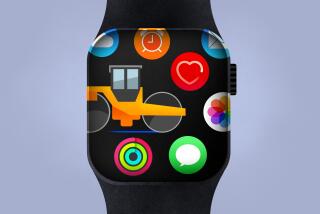The Cutting Edge: COMPUTING / TECHNOLOGY / INNOVATION : Radius Goes for a Slice of the Apple Pie : Computers: Some are skeptical that the small San Jose peripherals maker is up to the task.
- Share via
SAN JOSE — Shortly after Charles Berger arrived as the new chief executive of Radius Inc., he discovered most of the company’s 70 engineers consumed with a project they called Skylab. The engineers had designed a souped-up version of the Apple Macintosh personal computer, with 12 microprocessors versus the one of the original.
“It was a mini-supercomputer, not really a PC at all,” Berger recalls. Radius’ business was selling peripherals, monitors and printed circuit boards that added features such as speed and picture-pretty graphics to Apple’s Macintosh, but the company’s wildly creative engineers found such products much too mundane.
Skylab was rife with problems, not the least of them the fact that Apple had never granted anyone--let alone little Radius--permission to sell a Macintosh clone. Berger, who joined Radius in May and was explicitly charged with instilling order, grounded Skylab in August.
But now this collection of talented, spirited--and often undisciplined--engineers has become one of the first two companies officially authorized to build Macintosh clones. Apple hopes that allowing others to build the Mac will result in cheaper machines and enable the Apple technology to gain ground in the battle against industry standard PCs that use Intel chips and Microsoft software.
For Radius, building Mac clones represents a chance to enter the big leagues of the computer business, to be more than an obscure supplier of specialized peripherals. And the stakes are plenty high for Apple too: The company spent years agonizing over the decision to permit clones and another 18 months developing the details of its clone strategy, and it’s crucial that the early licenses do well.
*
Some are skeptical that Radius is up to the task. Berger readily concedes that Radius was not Apple’s first, or even second, choice. “They were pursuing the IBMs of the world,” he said. “We went to Apple, they didn’t come after us.”
And even though Radius doubled in size last year by buying rival Supermac Technology, it posted revenue of just $324.8 million in fiscal 1994--small by computer industry standards--and virtually no profit. Some say the company just isn’t big enough to play this new game.
“Radius doesn’t have the (financial resources) to launch a systems business,” Hambrecht & Quist analyst Bruce Lupatkin said. The other initial Apple licensee, Power Computing, is a start-up company, but it enjoys the backing of giant Olivetti of Italy.
But the critics may be underestimating a potentially important intangible: In Radius, Apple has a soul mate. An unsanctioned project such as Skylab, for example, would have caused alarm at many companies. But at Apple, many an idea has begun with an ambitious engineer. Even after projects were formally canceled, Apple engineers have been known to secretly continue working on them.
Berger himself is an Apple alumnus, having spent six years there in the mid-1980s before moving to Sun Microsystems, and he knows a thing or two about rebellious engineers.
Radius was founded in 1986 by Apple veteran Michael Boich and a few colleagues who had worked on the original Macintosh. Together, they tried to re-create the Apple of Steve Jobs: brilliant and chaotic. “In Steve’s eyes, management was a negative,” Boich has said.
They succeeded in many respects, but the company got too big for Boich to run. A professional manager, Barry James Folsom, was brought in to run the firm, but he was quickly driven out of his job when the engineers threatened to quit en masse. Boich returned briefly before handing the reins to Berger.
“Mike really loves technology,” said board member Regis McKenna. “He really doesn’t have the skills to run day-to-day operations.”
Berger has been managing a delicate balancing act: creating a nurturing environment for his gifted engineers while keeping them focused on the task at hand. “I think the consensus style works to a point,” Berger said. “I like to get lots of input because none of us knows everything, but what I get paid for is to make decisions, and so I will make them.”
*
Three weeks after Berger signed the contract with Apple in mid-December, Radius’ engineers finished a working clone of the Macintosh which they proudly showed at the January Macworld in San Francisco. Berger said Radius will ship its first Macintosh clone, a machine customized for publishing and video editing, under its own label sometime before June.
Radius hopes to stay below the radar of Apple--and other, big-name clone vendors who may yet emerge--by focusing closely on niche markets. But even if it doesn’t attack the mainstream PC business, making money on Mac clones won’t be easy.
And the company isn’t exactly starting from a position of strength. Radius eked out a profit of only $1.4 million, or 10 cents per share, in the quarter ended Dec. 30 as it struggled to assimilate Supermac.
It is feeling pressure from Apple in its core business, selling peripherals for the Macintosh. Apple continues to incorporate the very features offered by Radius add-in boards onto the Mac’s central processor. “Our race has always been to continue to stay ahead of Apple,” Berger acknowledged.
And for a quirky little company that has often tripped over its own feet, that task is now tougher than ever.

![Monrovia, CA - November 06: Original Apple-1 "NTI" motherboard and an Apple Cassette Adapter (ACI) in an original ByteShop Apple-1 koa wood case with Datanetics Keyboard Rev D [keyboard dated: Sept 21 1976]. Morgana Blackwelder with Hand-built Apple-1 displayed for auction at John Moran Auctioneers on Saturday, Nov. 6, 2021 in Monrovia, CA. (Irfan Khan / Los Angeles Times)](https://ca-times.brightspotcdn.com/dims4/default/ab3eeec/2147483647/strip/true/crop/2393x1600+4+0/resize/320x214!/quality/75/?url=https%3A%2F%2Fcalifornia-times-brightspot.s3.amazonaws.com%2Fee%2F8c%2Fa8b37d02425890021cfcd2b29c00%2Fla-photos-1staff-868241-me-1106-apple-first-unit-005.IK.JPG)




